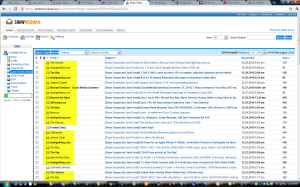Update: I wrote this too soon. This worked for a day or two, but then Thunderbird got out of sync again. I will have to try something different later.
Update 2: For a week or so, I have disabled mail.server.default.use_condstore in Thunderbird, as suggested here: http://www.ghacks.net/2013/09/07/fix-gmail-imap-slows-thunderbird-mails-arriving-timely-fashion/ – I’m again cautiously optimistic that it’s worked around the problem.
My email is currently hosted by Google and I use a mix of the web interface (often on multiple devices), Thunderbird on a workstation, and my phone to access email. For reasons unknown to me, a couple months ago Thunderbird client stopped updating itself when items were read or deleted from other devices or interfaces. I often resorted to closing Thunderbird, and re-opening it to force a re-synchronization.
I vaguely recall updating Thunderbird at about the same time that this issue started, but, I’m not 100% sure. I hadn’t updated in quite a while – probably over a year. Or, perhaps Google changed some settings on their end. I really don’t know.
I finally spent a bit of time trying to figure out a workaround or fix.
I disabled IDLE support in the email account in Thunderbird. It’s under Account Settings –> Server Settings –> Advanced. For those who don’t know, IDLE is supposed to push new email notifications to your email client, in this case, Thunderbird, more or less instantly. That’s normally a good thing.
Unfortunately, for whatever reason, disabling this seems to have fixed my Inbox’s “deleted” and “read” status issue, and I can live with a few minutes delay before my emails reach me.
